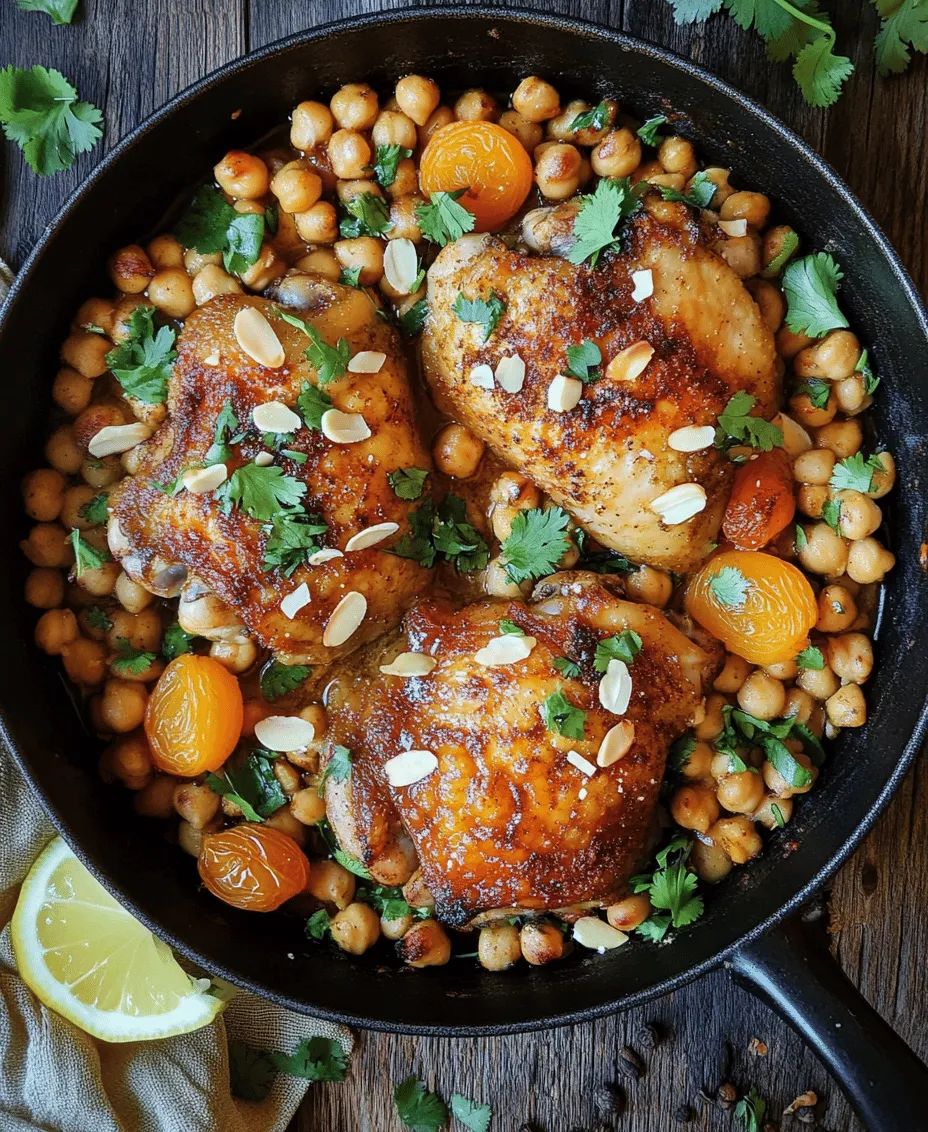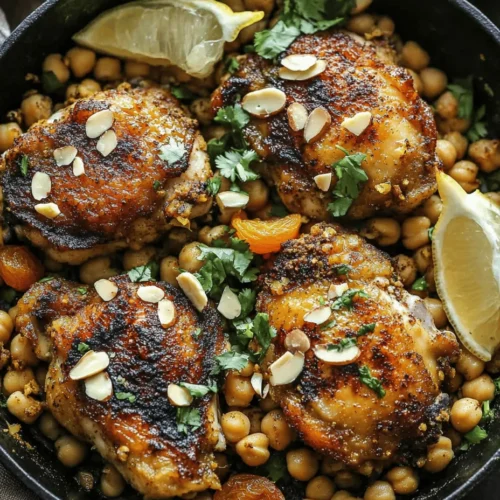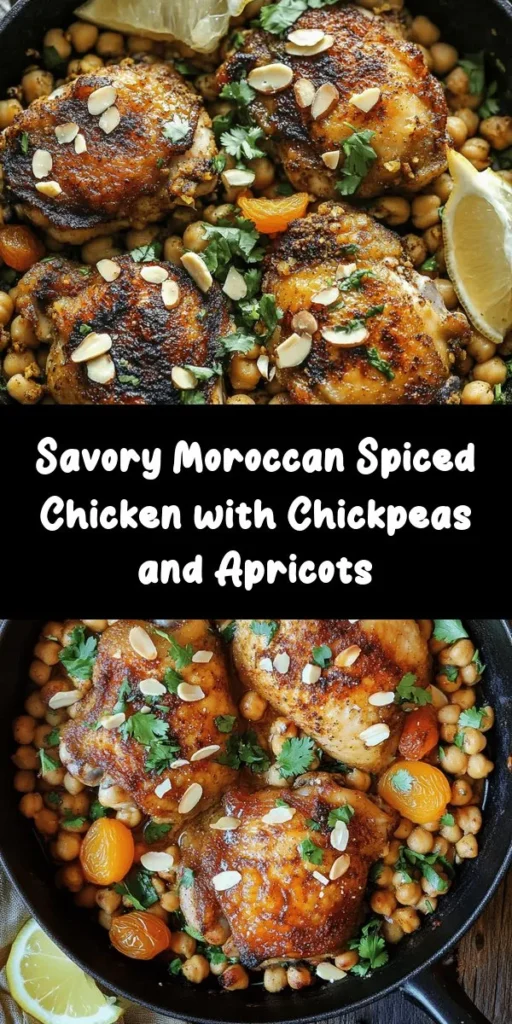Moroccan cuisine is a vibrant tapestry woven from the threads of various cultures and culinary traditions, creating a unique flavor profile that is both rich and diverse. At the heart of this culinary landscape lies a symphony of spices, fresh ingredients, and time-honored cooking techniques that come together to create unforgettable dishes. Among the many delights that Moroccan cuisine has to offer, Moroccan Spiced Chicken stands out as a quintessential representation of these flavors. This dish not only highlights the aromatic spices that characterize Moroccan cooking but also offers a delightful fusion of textures and tastes that will transport you to the bustling markets of Marrakech with each bite.
The essence of Moroccan Spiced Chicken lies in its harmonious blend of spices and wholesome ingredients that not only tantalize the taste buds but also nourish the body. The use of boneless, skinless chicken thighs ensures a tender and juicy result, while the accompanying spices impart a depth of flavor that is both exotic and comforting. Additionally, this dish is loaded with health benefits, making it a nutritious option for any meal. Incorporating wholesome ingredients such as chickpeas, dried apricots, and fresh herbs, Moroccan Spiced Chicken is not just a feast for the senses; it’s also a celebration of health and well-being.
Flavorful Ingredients and Their Benefits
To truly appreciate Moroccan Spiced Chicken, it is essential to delve into the ingredients that contribute to its vibrant flavor and nutritional profile. Each component plays a crucial role, enhancing the dish’s overall appeal.
Boneless, Skinless Chicken Thighs
At the heart of this dish is boneless, skinless chicken thighs. Unlike chicken breasts, which can often dry out during cooking, chicken thighs are rich in flavor and remain juicy and tender. They are also a great source of protein, providing essential amino acids needed for muscle repair and overall health. Additionally, chicken thighs contain healthy fats, which help to keep you satiated and energized throughout the day.
Olive Oil
Olive oil is another star ingredient in Moroccan Spiced Chicken, serving both culinary and health purposes. This golden elixir is packed with monounsaturated fats, which are known to promote heart health and reduce inflammation. When used in cooking, olive oil not only adds a rich, fruity flavor but also helps to enhance the absorption of fat-soluble vitamins from the other ingredients. It plays a crucial role in the marinating process, ensuring that the spices adhere well to the chicken and infuse it with flavor.
Onions and Garlic
Onions and garlic are foundational ingredients in Moroccan cuisine, providing a flavor base that elevates the dish to new heights. Onions add sweetness and depth, while garlic contributes a distinctive aroma and flavor that complements the spices beautifully. Beyond their flavor-enhancing properties, both onions and garlic are known for their health benefits. They contain antioxidants, promote heart health, and have anti-inflammatory properties, making them essential components of a balanced diet.
The Spice Medley
One of the defining characteristics of Moroccan Spiced Chicken is the carefully curated blend of spices that evoke the essence of Moroccan cooking. The spices used in this dish—cumin, coriander, cinnamon, paprika, turmeric, and cayenne—are not only critical for flavor but also carry cultural significance.
– Cumin is known for its warm, earthy flavor and is believed to aid digestion.
– Coriander adds a citrusy note and is rich in antioxidants.
– Cinnamon brings sweetness and warmth; it is also associated with anti-inflammatory benefits.
– Paprika adds a smoky depth, providing vitamins A and E.
– Turmeric is renowned for its anti-inflammatory properties, thanks to curcumin, its active compound.
– Cayenne offers a spicy kick and is known to boost metabolism.
Together, these spices create a fragrant and flavorful experience that is both comforting and invigorating.
Chickpeas
Chickpeas, or garbanzo beans, are a nutritional powerhouse that adds bulk and texture to the dish. They are an excellent source of plant-based protein, fiber, and essential vitamins and minerals. Including chickpeas in Moroccan Spiced Chicken not only enhances the heartiness of the dish but also provides sustained energy and helps to keep you feeling full. Their nutty flavor complements the spices beautifully, making them a natural addition to this recipe.
Dried Apricots
For a touch of sweetness, dried apricots are included in the mix. These chewy morsels add a delightful contrast to the savory spices and chicken. Dried apricots are also packed with fiber, vitamins A and C, and potassium, making them a healthy addition to the dish. Their natural sweetness balances the bold flavors, creating a harmonious blend of tastes.
Slivered Almonds
To introduce a satisfying crunch, slivered almonds are sprinkled over the finished dish. Not only do they add texture, but almonds are also a great source of healthy fats, protein, and vitamin E, making them a nutritious garnish. Their nutty flavor pairs perfectly with the spices and adds an additional layer of complexity to the dish.
Fresh Herbs
Fresh herbs, such as cilantro or parsley, play a pivotal role in Moroccan Spiced Chicken. They not only add a burst of freshness and color but also enhance the overall flavor profile. Fresh herbs are known for their health benefits, including antioxidant properties and the ability to aid digestion. They act as a finishing touch, elevating the dish and providing a vibrant contrast to the warm spices.
Lemon Wedges
Finally, lemon wedges serve as a zesty garnish that brightens up the dish. A squeeze of fresh lemon juice just before serving enhances the flavors and adds a refreshing quality to the meal. Lemons are rich in vitamin C and have numerous health benefits, including promoting hydration and aiding in digestion.
Marinating the Chicken for Maximum Flavor
One of the key steps in achieving the outstanding flavor of Moroccan Spiced Chicken is the marination process. Marinating the chicken allows the spices to infuse deeply, resulting in a more flavorful and tender dish. The importance of marinating cannot be overstated; it transforms the chicken into a succulent masterpiece.
Creating the Spice Rub
To create the spice rub, combine the blend of spices in a bowl with olive oil, minced garlic, and finely chopped onions. This mixture not only coats the chicken but also creates a paste that clings to the meat, ensuring that every bite is packed with flavor. The olive oil acts as a conduit for the spices, helping them to penetrate the chicken and providing moisture during cooking.
Marinating Time
For optimal results, allow the chicken to marinate for at least 1 hour, although marinating it overnight will yield even better flavor. The longer the chicken sits in the marinade, the more the spices will permeate the meat, resulting in a rich and complex flavor profile. If you’re short on time, even a 30-minute marinade will impart some flavor, but patience is key to achieving the best results.
Marination Methods
There are various methods for marinating chicken, including using a resealable plastic bag or a shallow dish. A resealable bag is often the most effective method, as it allows the marinade to coat the chicken evenly while taking up less space in the refrigerator. If you prefer a dish, ensure that the chicken is well-coated and cover it tightly with plastic wrap. No matter the method, be sure to refrigerate the marinating chicken to prevent bacterial growth.
Searing the Chicken: Achieving Perfect Texture
Once the chicken has marinated to perfection, it’s time to cook it. Searing the chicken is a crucial step that enhances the flavor while achieving a golden-brown crust. This process locks in moisture and creates a beautiful texture that is both crispy on the outside and tender on the inside.
The Searing Process
To sear the chicken, heat a large skillet or frying pan over medium-high heat. Add a splash of olive oil, allowing it to heat until shimmering but not smoking. Carefully place the marinated chicken thighs in the pan, ensuring not to overcrowd the skillet, which can lead to steaming rather than searing.
Recommended Tools and Techniques
A heavy-bottomed skillet, such as cast iron or stainless steel, is ideal for searing as it retains heat well and promotes even cooking. Use tongs to flip the chicken, ensuring that each piece is evenly browned on both sides. For added flavor, consider adding a few sprigs of herbs or a crushed garlic clove to the pan as the chicken cooks.
Visual Indicators
As you sear the chicken, look for visual indicators to determine when it’s done. The chicken should develop a deep golden-brown crust, and when you cut into it, the juices should run clear, indicating that it is fully cooked. This process not only enhances the flavor but also adds an appealing presentation to the dish.
By understanding the importance of each ingredient, the marinating process, and the searing technique, you can elevate your Moroccan Spiced Chicken to new heights. In the next sections, we will explore the final cooking steps and how to serve this aromatic dish, ensuring that every bite is a celebration of Moroccan culinary heritage.

Sautéing Aromatics: Building the Flavor Base
Aromatic vegetables are the backbone of many cuisines, and Moroccan Spiced Chicken is no exception. Onions and garlic play a pivotal role in developing the dish’s rich flavor profile. Starting with a good sauté not only enhances the overall taste but also sets the foundation for the subsequent layers of flavor.
Importance of Onions and Garlic in Flavor Development
Onions provide a natural sweetness when cooked down, while garlic adds depth and a slight pungency that complements the spices beautifully. The key to unlocking their full potential lies in the cooking method. When sautéing, it’s crucial to allow the onions to become translucent and slightly caramelized. This process amplifies their sweetness and mellows their sharpness, creating a balanced taste that permeates the entire dish.
Tips on Achieving the Right Texture and Color for Sautéed Aromatics
To achieve perfectly sautéed onions and garlic, follow these tips:
1. Use a High Smoke Point Oil: Opt for oils like vegetable or canola oil that can withstand high temperatures without burning.
2. Cook Over Medium Heat: This allows the onions to soften and release their moisture without burning. Stir frequently to prevent sticking.
3. Timing is Key: Sauté onions for about 5-7 minutes until they are soft and lightly golden. Add minced garlic in the last minute of cooking to prevent it from burning.
How to Deglaze the Pan Properly for Added Depth of Flavor
After sautéing your aromatics, you will notice some browned bits stuck to the bottom of the pan. These bits, known as fond, are packed with flavor and should not be discarded. To deglaze, pour in a splash of chicken broth or water while the pan is still hot. Use a wooden spoon to scrape up the fond as the liquid bubbles, incorporating those rich flavors into your sauce.
Creating the Sauce: Balancing Sweet and Savory
Now that your aromatics are perfectly sautéed, it’s time to create the sauce that will envelop your chicken in flavor.
Step-by-Step Instructions on Building the Sauce with Broth
1. Add Spices: Once your aromatics are ready, add the Moroccan spices (such as cumin, coriander, cinnamon, and paprika) to the pan. Toast them for about 30 seconds to release their essential oils and deepen their flavor.
2. Pour in the Broth: Gradually add 1 to 2 cups of chicken broth, stirring continuously. This will create a flavorful base for your sauce. Adjust the amount of broth depending on how saucy you want your dish.
3. Introduce the Sweet Ingredients: Add in 1 cup of drained chickpeas and 1 cup of chopped dried apricots. The chickpeas add protein and texture, while the apricots provide a touch of sweetness that beautifully balances the spices.
4. Simmer Together: Bring the mixture to a gentle simmer, allowing the flavors to meld together for about 10 minutes. This step is crucial for the sauce to develop its complexity.
Discussing the Importance of Chickpeas and Apricots in the Dish
Chickpeas are not only a great source of protein but also help absorb the spices and flavors of the sauce, adding a hearty element to the dish. Meanwhile, dried apricots introduce a delightful sweetness that contrasts beautifully with the savory spices, embodying the Moroccan philosophy of balancing flavors.
How to Incorporate the Seared Chicken Back into the Sauce for Flavor Infusion
After your sauce has simmered and thickened, it’s time to add the seared chicken back into the pan. Nestle the chicken pieces into the sauce, ensuring they are well-coated with the mixture. Allow them to simmer for an additional 15-20 minutes. This step is essential, as it permits the chicken to absorb the aromatic flavors of the sauce, resulting in incredibly tender and juicy meat.
Simmering to Perfection: Cooking Techniques for Tender Chicken
Cooking chicken perfectly is an art, and understanding the difference between simmering and boiling is crucial for achieving tender results.
Overview of Simmering vs. Boiling and Why It Matters
Simmering involves cooking food gently in liquid at a temperature just below boiling, typically around 185°F to 205°F. This method allows the chicken to cook through without becoming tough or dry, as boiling can often lead to overcooking.
Ideal Temperature Settings for Simmering
To maintain the perfect simmer:
– Keep your heat at medium-low.
– Use a thermometer to check the temperature if necessary; it should be just bubbling, with small bubbles rising to the surface.
Signs That the Chicken is Tender and Ready to Serve
After simmering, the chicken should be cooked through and tender. To check for doneness, cut into a piece of chicken; the juices should run clear, and the meat should no longer be pink. Furthermore, the chicken should easily pull apart with a fork, indicating it is perfectly tender and ready to enjoy.
Finishing Touches: Texture and Presentation
As you near the final stage of your Moroccan Spiced Chicken, the finishing touches can elevate your dish from good to exceptional.
Importance of Adjusting Seasoning Before Serving
Before serving, taste the sauce and adjust the seasoning. Depending on your preferences, you may want to add a pinch of salt or a squeeze of fresh lemon juice to brighten the flavors. This step ensures that every bite is perfectly balanced.
How to Incorporate Toasted Almonds for Crunch
For added texture, sprinkle toasted slivered almonds over the chicken just before serving. The nutty flavor and crunch contrast beautifully with the tender chicken and soft chickpeas, enhancing the overall eating experience.
Visual Presentation Tips to Enhance the Dish’s Appeal
Presentation matters, especially in Moroccan cuisine, where vibrant colors and textures are celebrated. Serve the Moroccan Spiced Chicken in a large, shallow dish. Garnish with fresh cilantro or parsley for a pop of color, and consider serving it with a wedge of lemon for added brightness. Pairing the dish with colorful side dishes also enhances its visual appeal.
Serving Suggestions and Pairing Ideas
The right accompaniments can elevate your Moroccan Spiced Chicken into a complete meal. Here are some suggestions:
Best Side Dishes to Complement Moroccan Spiced Chicken
1. Couscous: Fluffy couscous absorbs the sauce beautifully and adds a wonderful texture to the meal.
2. Rice: A fragrant jasmine or basmati rice provides a neutral base that contrasts well with the spiced chicken.
3. Warm Pita Bread: Perfect for scooping up chicken and sauce, pita adds an element of fun to the dining experience.
Suggested Beverage Pairings to Enhance the Dining Experience
For a well-rounded meal, consider pairing Moroccan Spiced Chicken with:
– Mint Tea: A traditional Moroccan beverage that complements the spices perfectly.
– Red Wine: A glass of fruity red wine can enhance the savory notes of the dish.
– Sparkling Water with Citrus: The effervescence and acidity can cleanse the palate between bites.
Cultural Context of Serving Meals in Moroccan Cuisine
In Moroccan culture, meals are often served family-style, encouraging shared experiences. Traditionally, food is enjoyed from a communal platter, and it’s common for diners to use their hands to pick up food. This creates a sense of togetherness and celebration, making the meal not just about nourishment, but also about connection.
Conclusion: Savoring the Experience of Moroccan Spiced Chicken
Moroccan Spiced Chicken is more than just a meal; it is an invitation to explore the rich tapestry of Moroccan culture through its flavors and traditions. The harmonious blend of spices, the contrasting textures of the chickpeas and almonds, and the sweetness of the apricots come together to create a dish that is both comforting and exotic.
As you savor each bite, reflect on the culinary journey this dish represents. It embodies the warmth of Moroccan hospitality and the joy of cooking from the heart. I encourage you to delve deeper into Moroccan cooking, experimenting with spices and ingredients that evoke the vibrant markets of Marrakech or the tranquil landscapes of the Atlas Mountains.
Cooking is a beautiful act of love and sharing, and this Moroccan Spiced Chicken recipe offers the perfect opportunity to gather your loved ones around the table. Enjoy the process, savor the flavors, and create lasting memories through the meals you prepare.



